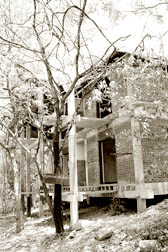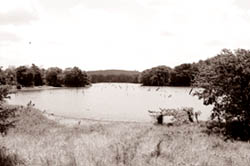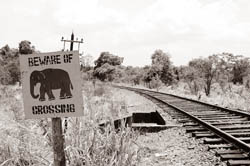|
DAILY NEWS ONLINE |
|
|
|
OTHER EDITIONS |
|
|
|
|
|
|
|
|
|
OTHER LINKS |
|
|
|
|
|
|
  |
In the cradle of Sinhala civilization, a resplendent wildlife nursery
The backbone of ancient Sri Lanka's agriculture based cultural heritage was her network of irrigation systems intrinsically interwoven with the natural environment. The Kaudulla National Park in Polonnaruwa lays claim to a slice of Sri Lanka's ancient history and legend dating back to the era of the Sinhala Kings. With a 104,000-acre capacity feet of water, Kaudulla Tank was built by a princess - the sister of the famous King Mahasen who built the neighbouring Minneriya Tank. Today both tanks are a part of Sri Lanka's proud hydraulic civilization.
Kaudulla National Park was hidden in Polonnaruwa's jungles till the recent past until its declaration as the 15th National Park on April 01, 2002. Kaudulla is unique in being the only National Park in Sri Lanka with almost two thirds of its land area under water during several months of the year. It can be termed as 'A Water Wonderland in the heart of Sri Lanka.' Now Kaudulla National Park has been brought under the Protected Area Management and Wildlife Conservation Project of the Department of Wildlife Conservation and is being sustainably developed and preserved for posterity under the direction of Director General Dayananda Kariyawasam and Project Director H.G.Gunawardene. Kaudulla National Park was also on the agenda of the journalists' familiarisation tour organised recently by the Promotion and Environmental Education Unit of the Environment and Natural Resources Ministry. Biodiversity
Kaudulla National Park (KNP) consists of a many splendoured landscape and offers visitors scenic beauty and diverse wildlife on an idyllic wetland setting with a view of elephants almost always guaranteed. The cyclic seasonal changes in the water levels and spread of the tank creates a unique set of ecosystems which sustains a rich and diverse flora. This diversity of luxurious floral species ensures an array of food, shade and refuge for an equally diverse fauna. The vegetation prevalent in the KNP is a complex of woodland-grassland-wetland. The KNP is bestowed with a number of water sources - Kaudulla Tank, the Relapanawa Tank, Minneriya-Kantale Yodha Ela, Aluth Oya, Hathereskotuwa Oya, Olumadu Wewa and Puliyan kalla Wewa. Fauna species include Elephant, Deer, Sambur, Wild Boar, Leopard, Bear, Birds, Fish etc. Kaudulla NP is located in the heart of the dry zone elephant territory where large herds of elephants congregate during the dry season. It is also within several important elephant migratory routes. This makes Kaudulla NP one of the best natural habitats in Sri Lanka for viewing elephants throughout the year. Another fascinating feature of the Kaudulla Tank is adjacent wetlands which include an ancient canal that runs through it and an interesting waterway with several little islands which can support both indigenous and migrant species of birds. Developments
The 6900 ha. Kaudulla NP is poised to become an eco-tourism haven under the proposed developments of the Protected Area Management and Wildlife Conservation Project (PAM & WC) which commenced development work in 2004. Activities also include the management of the elephant corridors of KNP - Minneriya National Park and KNP - Ritigala. The current situation of KNP is that it lacks visitor facilities, sufficient trackers and less benefits to local communities. A wide development strategy has been mapped out for Kaudulla. With the elephant as its flagship species, reservoir catchments, biodiversity and cultural diversity will be conserved. The entire development programme is based on community adaptive management, ensuring benefits to buffer zone communities, providing opportunities for eco-tourism, maintaining habitats suitable for elephants, protection of the unique culture and biodiversity of the areas. Kaudulla National Park Warden D.M.Weerasinghe outlined the difficult path he treads to solicit the support of the villagers for the development and protection of the park. Villagers had been depending on the park resources for their existence.
Encroachment, fishing, illegal timber felling, hunting for small animals, poaching for ivory, grazing, fuelwood collection were threats posed to the park. The Community Outreach Programme an important component of the PAM & WC Project was launched to rectify these issues. Traditionally fishing had been the main livelihood of the buffer zone villagers and around 1000 persons had been engaged in fresh water fishing in the Kaudulla Tank. Through constant negotiations and education of these villagers by the Park officials agreement had been reached to regularise fishing in the KNP area and to introduce alternate modes of livelihood such as agriculture and livestock development. With the regulation of fishing activities the DWLC will issue identity cards for fishermen to enter the KNP and engage in their trade according to a timetable. Cattle farming was also prevalent within the park with around 30 cattle farmers residing within. As much as 4000 cattle belonging to these farmers graze within the park resulting in food shortages for elephants and other herbivores. The cattle farmers have agreed to a proposal by the Park Officials to supply them with cattle of good breed for milk from the Livestock Development Board in exchange for their excess cattle. Furthermore villagers have already evacuated a large number of cattle from the park. Villagers earlier had been in the practice of setting fire to areas within the park to enable new grass to shoot up for the cattle. This practice has been stopped forthwith and 25 ha. of fire-belts have been created. Work on an extent of 5 ha. of grasslands for the elephants is in progress. Fast spreading invasive plants particularly Lantana, poses a threat to the park's vegetation. Out of a 50 ha. extent 25 ha. have been cleared. Studies on impact of invasive species and cattle grazing are currently on and the management of cattle and buffalo population with National Livestock Development Board (NLDB) and Mahaweli Authority is continuing. Kaudulla NP at present has a 16 kilometre road network and minimum visitor facilities. Yet it is considered a natural base with much potential for eco-tourism. As such attractions such as boating, bathing areas, guided safari tours, nature trails, picnic and camping sites for both children and adults, viewpoints for birds and crocodiles have been included in the development agenda. Human-elephant conflictThe infrastructure is being built in with new staff quarters, office and museum complex, auditorium, visitor centre, drinking water facilities, recreation and toilet facilities. At present the museum is housed in a tent. The staff cadre is also being beefed up. One beat office has been set up at Menik Sorowwa and two more beat offices are proposed to be set up at Goma Handiya and Aluth Oya. Incidents of the human-elephant conflict have been recorded from the KNP vicinity. Elephants do not like the rain. When the rainy seasons set in elephants migrate to other KNP surrounding areas and the Habarana jungles in search of food and water. This is also an occurrence during seasons when villagers set fire to park vegetation. In the year 2004-2005 seventy five elephants had been killed in train accidents during elephant migratory seasons. Train accidents occur along a distance of about 17 kms. on the Minneriya-Kaudulla corridor. The PAM & WC Project also envisages the acquisition of around 1000 ha. of land beyond the KNP protected area boundaries which is frequented by elephants during the rainy season. Community participation in KNP developments has been ensured for the overall development of the park. Park officials are in constant touch with community leaders, the police and the army in protecting the KNP. To ensure further community participation nine trackers have been enlisted for park service from the Rotawewa village and are being trained as guides. The final result of the developments will be the long-term conservation of the biodiversity of the Kaudulla National Park and the promotion of conservation compatible tourism. |
|||||
|
|





